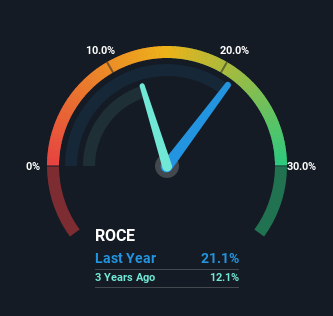Finding a business that has the potential to grow substantially is not easy, but it is possible if we look at a few key financial metrics. Amongst other things, we’ll want to see two things; firstly, a growing return on capital employed (ROCE) and secondly, an expansion in the company’s amount too capital employed. If you see this, it typically means it’s a company with a great business model and plenty of profitable reinvestment opportunities. Looking at Honma Golf (HKG:6858), it does have a high ROCE right now, but let’s see how returns are trending.
Understanding Return On Capital Employed (ROCE)
If you haven’t worked with ROCE before, it measures the ‘return’ (pre-tax profit) a company generates from capital employed in its business. To calculate this metric for Honma Golf, this is the formula:
Return on Capital Employed = Earnings Before Interest and Tax (EBIT) ÷ (Total Assets – Current Liabilities)
0.21 = JP¥6.1b ÷ (JP¥44b – JP¥15b) (Based on the trailing twelve months to September 2022).
Therefore, Honma Golf has a ROCE of 21%. That’s a fantastic return and not only that, it outpaces the average of 4.2% earned by companies in a similar industry.
See our latest analysis for Honma Golf

While the past is not representative of the future, it can be helpful to know how a company has performed historically, which is why we have this chart above. If you’d like to look at how Honma Golf has performed in the past in other metrics, you can view this free graph of past earnings, revenue and cash flow.
What The Trend Of ROCE Can Tell Us
Over the past five years, Honma Golf’s ROCE and capital employed have both remained mostly flat. It’s not uncommon to see this when looking at a mature and stable business that isn’t re-investing its earnings because it has likely passed that phase of the business cycle. Although current returns are high, we’d need more evidence of underlying growth for it to look like a multi-bagger going forward.
Another point to note, we noticed the company has increased current liabilities over the last five years. This is intriguing because if current liabilities hadn’t increased to 35% of total assets, this reported ROCE would probably be less than 21% because total capital employed would be higher. The 21% ROCE could be even lower if current liabilities weren’t 35 % of total assets, because the formula would show a larger base of total capital employed. With that in mind, just be wary if this ratio increases in the future, because if it gets particularly high, this brings with it some new elements of risk.
The Key Takeaway
Although it is allocating its capital efficiently to generate impressive returns, it isn’t compounding its base of capital, which is what we’d see from a multi-bagger. And investors appear hesitant that the trends will pick up because the stock has fallen 40% in the last five years. In any case, the stock doesn’t have these traits of a multi-bagger discussed above, so if that’s what you’re looking for, we think you’d have more luck elsewhere.
On a separate note, we’ve found 1 warning sign for Honma Golf you’ll probably want to know about.
If you’d like to see other companies earning high returns, check out ours free list of companies earning high returns with solid balance sheets here.
Valuation is complex, but we’re helping make it simple.
Find out whether Honma Golf is potentially over or undervalued by checking out our comprehensive analysis, which includes fair value estimates, risks and warnings, dividends, insider transactions and financial health.
View the Free Analysis
Have feedback on this article? Concerned about the content? Get in touch with us directly. Alternatively, email editorial-team (at) simplywallst.com.
This article by Simply Wall St is general in nature. We provide commentary based on historical data and analyst forecasts only using an unbiased methodology and our articles are not intended to be financial advice. It does not constitute a recommendation to buy or sell any stock, and does not take into account your objectives, or your financial situation. We aim to bring you long-term focused analysis driven by fundamental data. Note that our analysis may not factor in the latest price-sensitive company announcements or qualitative material. Simply Wall St has no position in any stocks mentioned.